
June 30 2018 march of apx. 25,000 from Dolores Park to Civic Center, part of a wave of nationwide protests against the incredibly cruel family separation policy.
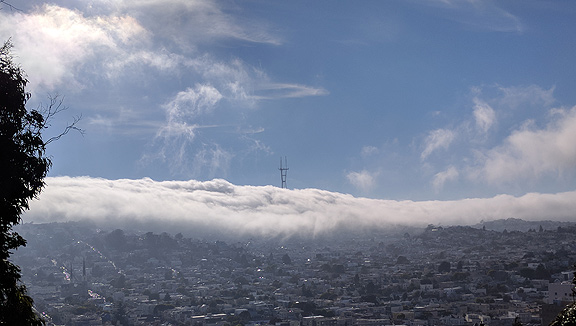
It’s summer in San Francisco, which comes with free air conditioning (whether you want it or not!). The rest of the Bay Area and most of California, and in fact a great deal of the world seems to be suffering sweltering, record-breaking heat. Here, hot air meets the cold ocean and we reliably get cooling fog, or as it’s known locally “Karl the Fog.”
Then there’s the other fog. The fog of lies and insults that passes for presidential communications these days. But that’s not worth thinking about, except to note that it is traumatizing for millions of people, and the daily repetition is producing a society numb or trembling with post-traumatic stress disorder. The unbearable cruelty of separating small children from their parents at the border has put us all in the position of being forced to watch torture carried out in our name. I just saw a piece on The Intercept where they found a 4-year-old and her 15-month-old sister still separated from their parents. It’s just so horrifying. While there have been some spirited protests and occupations at ICE offices, the story was mostly buried after the fake retreat by the administration. Overall the trumpian strategy works at throwing people on the defensive. Before they can get their bearings and actively resist, the attack shifts again, the assault comes from a new direction. Many people just grow more exhausted and demoralized—exactly as planned!
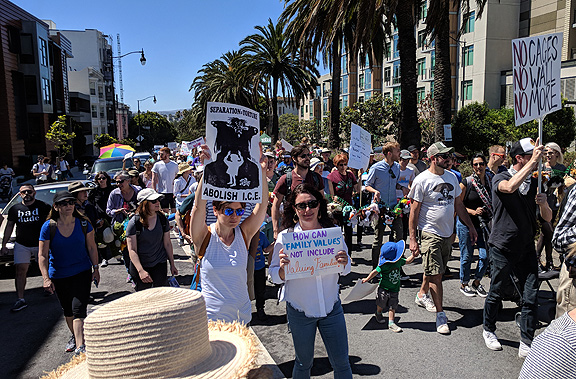
on Dolores Street, June 30
I don’t think there’s any real agenda driving this madness beyond personal enrichment and the insatiable lust for attention of one of history’s most childish and needy narcissists to ever gain executive power. But it doesn’t do us much good to spend time analyzing him, trying to find a crack in the fragile edifice of this immeasurably shallow, stupid, and casually cruel sociopath. Clearly the people in the administration have an aggressive agenda to attack anything associated with ecological sanity, seize resources and public assets, and destroy whomever stands in their way. I keep track of the ongoing descent into barbaric chaos mostly online and on late night comedy, but have abandoned my former attentiveness to the “news.” I know it’s very bad out there as the kleptocrats, militarists, racists, and assholes are riding high. I think they will get their comeuppance eventually, but I also know that such thoughts could be nothing more than a revenge fantasy based in an exaggerated sense of karma and ultimate justice. Time will tell I suppose.
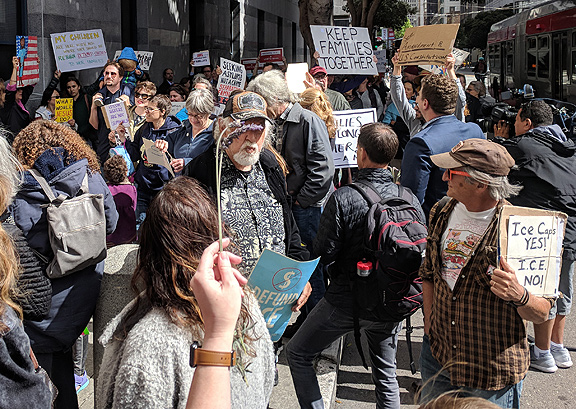
Ice Caps Yes, ICE No! June 15, quickie demo at ICE offices on Sansome Street.

March to Civic Center, June 30
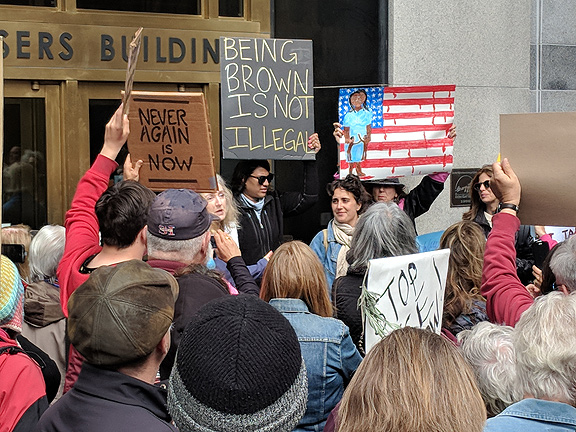
June 15 at ICE doors.

Instead of wringing my hands, or betting on a blue-female wave saving us in the midterms, I’ve been doing a lot of reading and thinking and writing. I’ve got a new book on local history coming out next spring. We’ve been putting together our Fall schedule for Shaping San Francisco’s Talks and Tours. And I’m on the board of the San Francisco Community Land Trust (also my “landlord”) and helping to work through some essential organizational dynamics. And of course I’m out walking a lot, so if you’re on the streets of San Francisco and see me strolling by, say “hi!”
And I’ve popped out to a variety of demonstrations that have been erupting regularly on local streets. On May 31, I joined with a variety of comrades to blockade over a dozen tech shuttle buses at 24th and Valencia, using the suddenly ubiquitous e-scooters to build small barricades. The e-scooters themselves were widely reviled as they cluttered our streets (since removed) and are a sickening kind of get-rich-quick e-waste with a projected lifespan of only 3 months, depending on low-paid gig workers to collect, recharge, and reallocate them to the streets each morning. Yuck! On June 15 I made my way downtown on a quick call to join with a few dozen folks in front of the ICE offices here. There’d been a lockdown/blockade there a couple of months earlier, and an occupation closed its driveways for about a week over the July 4 week before the police rousted it. June 30 tens of thousands joined nationwide protests, marching from Dolores Park to the Civic Center, following the usual big marches during the Gay Pride weekend June 22-24.
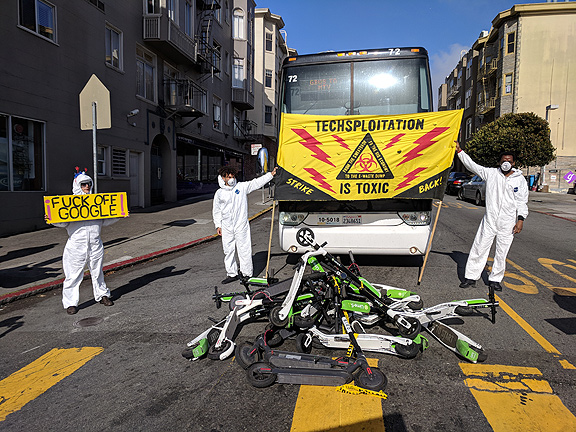
May 31 blockade of 24th and Valencia, using the e-scooter junk to continue local protests against tech displacement and evictions.

Folks from San Jose and Berlin joined in…
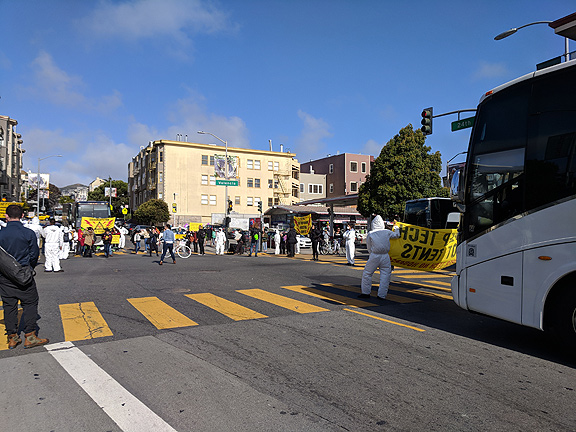
Tech shuttles piled up in all directions for the 2 hours of the protest.
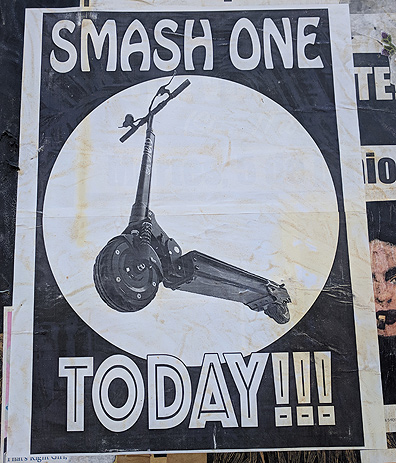
local poster makers continue to fill our walls…. thank you!
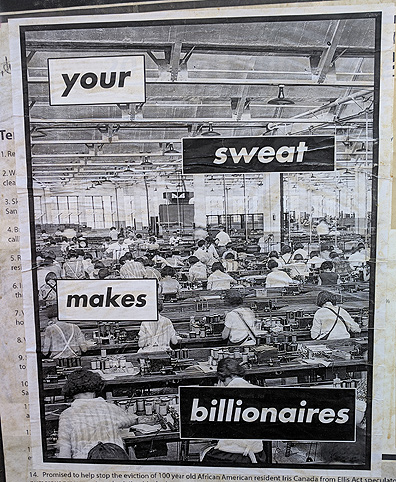
On “Democracy Wall” on Valencia’s former police station.

After the Supreme Court’s Janus decision, union activists were out, and I caught these folks as they were wrapping up for the day…

At the Civic Center, protest flowed through public art to create some interesting images.

My reading has taken me deep into the past. How did we get here, and why do we seem to repeat things that some of us imagined were over and done with? Philosophical and historical works intersect to unravel some of the deeper logic underpinning our shared predicament in 2018.
For example, I read about the worst defeat suffered by the U.S. military in battle with an army of Indians—it was in 1791, a battle with no name in the history books. Determined to take the Ohio River valley (then the “northwest territories”) George Washington sent General Arthur St. Clair and the first U.S. Army across the Appalachians to push a coalition of tribes out of the rich lands of today’s western Pennsylvania, Ohio, and Indiana. Due to a combination of reasons, including corrupt suppliers who failed to deliver food and material which delayed the expedition into early winter, the army was routed, hundreds killed, and colonist settlers forced to retreat eastward for a couple of years. Washington himself had long been a land speculator, and fully supported the efforts to seize native lands west of the Appalachians (one of the driving motivations for the American war of independence because for a time England tried to restrain western migration). Colin Galloway has written an excellent concise history The Victory With No Name: The Native American Defeat of the First American Army:
Despite the intention of government ordinances, “it was the speculators in Philadelphia, New York, and Boston who reaped the harvest.” The Northwest Territory was a land of opportunity for the nation, for settlers, but above all for the land companies. “Free enterprise was born out of land dealing,” wrote the late Andro Linklater, author of Measuring America, “and long before the first business corporation existed, land companies issued shares and created many of the financial and legal structures that the nineteenth-century stock-dealing, capitalist economy used to finance the railroads and industrialization of the United States.”
Robert Hamilton, a prominent Canadian merchant and an accomplished land speculator north of the border, blamed American land hunger: “The Americans seem possessed with a species of mania for getting lands, which have no bounds. Their Congress, prudent, reasonable, and wise in other matters, in this seems as much infected as the people.”
Converting common lands into parcels for sale drives the entire history of the United States. In This Radical Land: A Natural History of American Dissent Daegan Miller ponders this process and clarifies how abstracting a standard measurement from actual complicated physical places provided a basis for what is naturalized as “settlement:”
We abstract to connect—land is land; forty square acres anywhere is equivalent to forty square acres everywhere else. But if abstraction brings clarity and connections to disparate things flung across great distances, it can do so only through severing the tangled roots that plot any thing in a local place… What must be ignored in order to think that a parcel of land in one place is like a similarly sized parcel anywhere else? One way to answer that question is to look at what was abstracted out of the picture—people: squatters, wanderers, and above all else, American Indians; and also topography, flora and fauna, and ecology. The grid turned real places into abstract spaces, and it was that perfect grid of mitotic squares, spreading out effortlessly into the sunset, that helped eventually give Americans the idea that the continent was empty, the land free for the taking as along as a well-trained property surveyor was near at hand… the very first big-business trust in America, from the late eighteenth century, was a real-estate outfit named the North American Land Company.
My pal Raj Patel has teamed up with Jason Moore to write a very useful book A History of the World in Seven Cheap Things: A Guide to Capitalism, Nature, and the Future of the Planet. In it they explain in very clear language how the world system only works because vital ingredients have been so cheapened that they subsidize the cycles of exploitation required for profitability. It’s highly accessible and well worth a read as you ponder how such an insane organization of life manages to keep on going in spite of so many reasons why it shouldn’t. It’s not that cheap stuff arose on its own, of course.
Our cheap things didn’t magically make themselves. They emerged through a violent alchemy of ideas, conquest, and commerce in the modern world. At its heart has been a series of binaries that entwined with each other from the beginning: Society and Nature, colonizer and colonized, man and woman, the West and the Rest, white and not-white, capitalist and worker. Each of these dualisms has not merely worked to describe and categorize the world but served practically to dominate and cheapen the lives of nearly all humans and the rest of nature.
Dualisms and binaries? Do they really explain our predicament? One of my favorite writers on matters ecological, social, and political these days is George Monbiot, a Guardian columnist. He referred to a book several months ago that peaked my interest and I’ve since plowed through its 400+ pages, The Patterning Instinct by Jeremy Lent (who apparently lives in the East Bay!). Lent goes through an epic historical account of the evolution of languages, ideas, and cultures across the planet, seeking to demonstrate his argument that humans naturally seek to impose patterns on the world to make knowing it possible. Simply put, he argues that culture shapes values, and those values shape history. He integrates modern scientific insights too, but spends a good deal of time showing how deep assumptions emerged from linguistic structures in different parts of the world, and how those assumptions went in different directions long before the modern era. In the roots of what became the “Western” tradition he identifies an embrace of gods separate from the natural world, an idea that grew stronger and more absolute with monotheism. In the Eastern spiritual tradition he identifies a focus on harmony with the natural world and the “proper order” of life. Neither world view precluded hierarchy or slavery. But one led eventually to the scientific revolution based on a mechanistic view of the world where nature and other life forms were reduced to inanimate resources, while the other embraced science and technology in a context of balancing energies while embedded among all forms of life and the planet itself. He presents an example of Western dualism in the Gospel of John which
aptly sums up the awful dilemma of this dualistic cosmos: “Anyone who loves their life will lose it, while anyone who hates their life in this world will keep it for eternal life.” Over the centuries, this dualistic cosmology permeated European cognition.
He advocates a more integrative, wholistic systems approach by the end of the book:
In place of the root metaphors such as NATURE AS MACHINE and CONQUERING NATURE, the new worldview would be based on the emerging systems view of life—recognizing the intrinsic interconnectedness between all forms of life on earth and seeing humanity as embedded integrally within the natural world.
Sounds fine to my ears of course. But I live in Northern California where this kind of thing has been articulated for decades now. I remember going to a class on “Transtantric Philosophy” in 1975 at Sonoma State that sent me running away to find some practical political activity. Looking at patterns of thought at age 18 seemed to me at the time like contemplating how many angels could dance on the head of a pin. “What about all the injustice in the world?” I thought. But now, over 40 years later, and at the other end of a long neoliberal unraveling of the world I grew up into, unpacking the patterns of thought that make growing inequality, ecological destruction, and chronic war logical and appropriate feels urgent. Lent knows that so far we’re on the losing end of an ideological struggle:
Our modern world is the result of the runaway success of one of the most powerful cognitive patterns in history. Capitalism triumphed over competing ideologies with its seductive precept that, by selfishly pursuing individual financial gain, each person was contributing to the greater benefit of society. With the advent of “consumptionism,” capitalism instilled an intoxicating new purpose into people’s lives, promising them that their feelings of emptiness, meaninglessness, or alienation could be cured through the possession and conspicuous use of manufactured goods. No matter that the “cure” was only temporary: through hard work and dedication, you could earn more money to purchase even more goods, thus stepping on to the hedonic treadmill.
Daegan Miller challenges that ideological hegemony in his eloquent ruminations on nature and dissent:
… business culture didn’t triumph in the 19th century, nor has it today. What has triumphed is the story that all American culture is business culture, that free markets and free humans go hand in hand, that conquering space and time has enthroned us all, that the world is made of inert matter free for the taking, that we can invent and buy our way to a better tomorrow. Those are the stories of the already dead. We who live today need something better.
Patel and Moore remind us that the dualistic separation of nature and humans that gave rise to modern capitalism depended too on a reconfiguration of women in society:
The second law of capitalist ecology, domination over nature, owed much to Francis Bacon (1561-1626), a philosopher widely credited as the father of modern science. (That gendered language will make sense in a moment.) Bacon was also a prominent member of England’s political establishment, at different times a member of Parliament and the attorney general of England and Wales. He argued that “science should as it were torture nature’s secrets out of her.” Further, the “empire of man” should penetrate and dominate the “womb of nature.” Science must “hound nature in her wanderings, and you will be able, when you like, to lead and drive her afterwards to the same place again… Neither ought a man to make scruple of entering and penetrating into these holes and corners, when the inquisition of truth is his whole object.” Bacon was a major political figure at a time when the lives of European women were being threatened, surveilled, and dominated in new—and thoroughly modern—ways. The invention of Nature and Society was gendered at every turn.
I’ve been working on a kind of manifesto which I’ll post here soon. Trying to articulate a world and a life worth living and fighting for, I always return to my first question: why do we do what we do? Why do we make this world and not a world pleasant and convivial for all? Seems so straightforward to me! Patel and Moore end in almost the same place:
Never under capitalism have the majority been asked about the world we’d like to live in. To dream, and dream seditiously, is something that many humans need to practice, for we have been prevented from doing it for centuries. And the shop floors and community centers and classrooms and kitchen tables where these dreams will be shared are themselves subject to reimagination. Rather than seeing work as drudgery, restoration ecology offers joy, looking for working and living spaces to be filled with equitable chances for recreation.
To dreaming seditiously!

This memorial the Abraham Lincoln Brigade that fought against the fascists in 1930s Spain is in such a strange spot!… but it feels right to have an anti-fascist memorial now that our homegrown version is taking root.
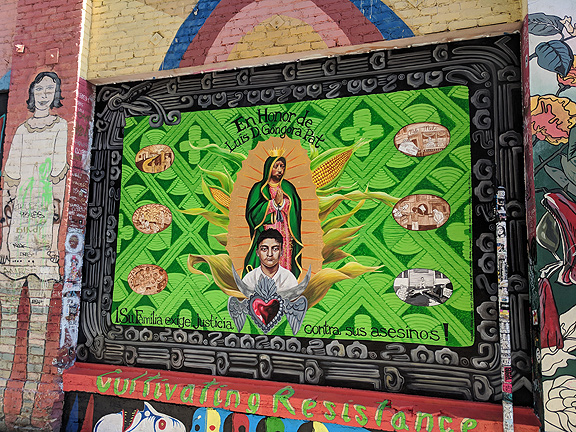
Memorial mural to Luis Gongora Pat, murdered by San Francisco Police on April 7, 2016… District Attorney George Gascon refused to press charges against the officers, who killed him in less than 30 seconds after their arrival as he sat on the ground.
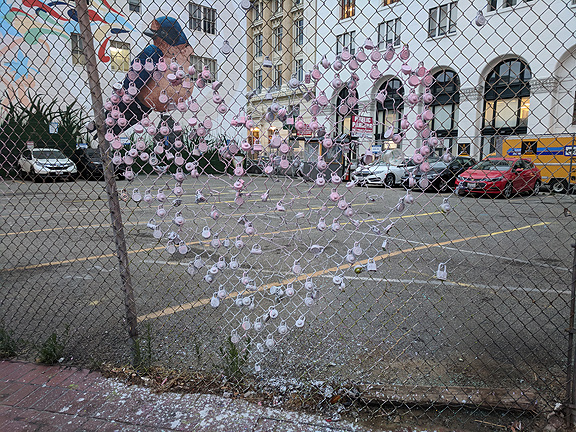
Public art near Market and Van Ness… strangely poignant, a heart made of padlocks.
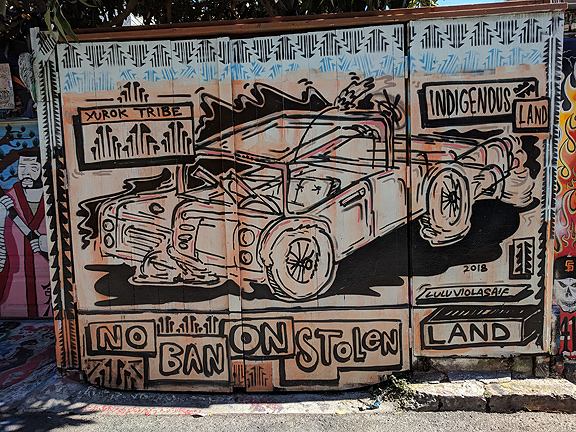
New mural in Clarion Alley caught my eye.

R.I.P. Carlos Gutierrez! You will be missed.












There seem to be dwindling numbers of sites to profit from checking into, but yours is always one of them.
Clarification of difference along with excellent insight seems to be the point of this snooping in for me – 1. Lent’s stuff seems New Agey vapidity to me, and 2. the world seems to be made around us, rather than by us.
Hence, never-ending stupidity, but we still have to make our way through it with good times and great oldies. Manifesto away!
Always appreciate your book recommendations, Chris!